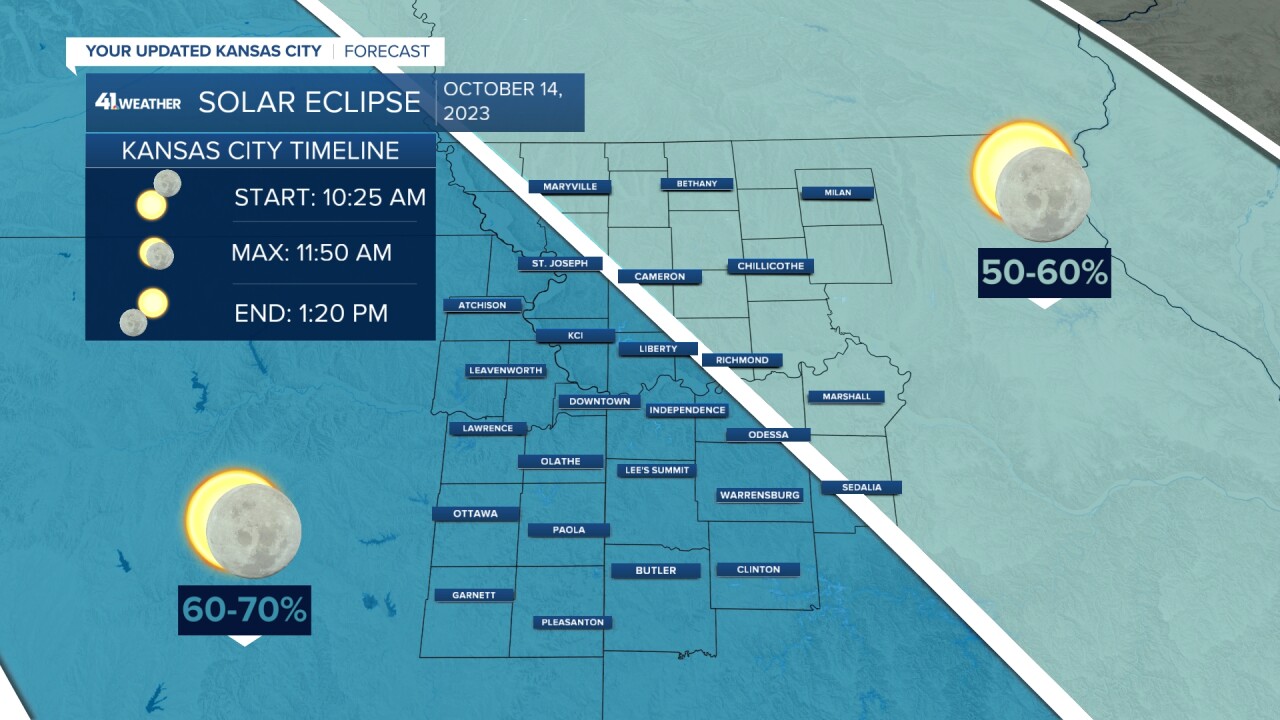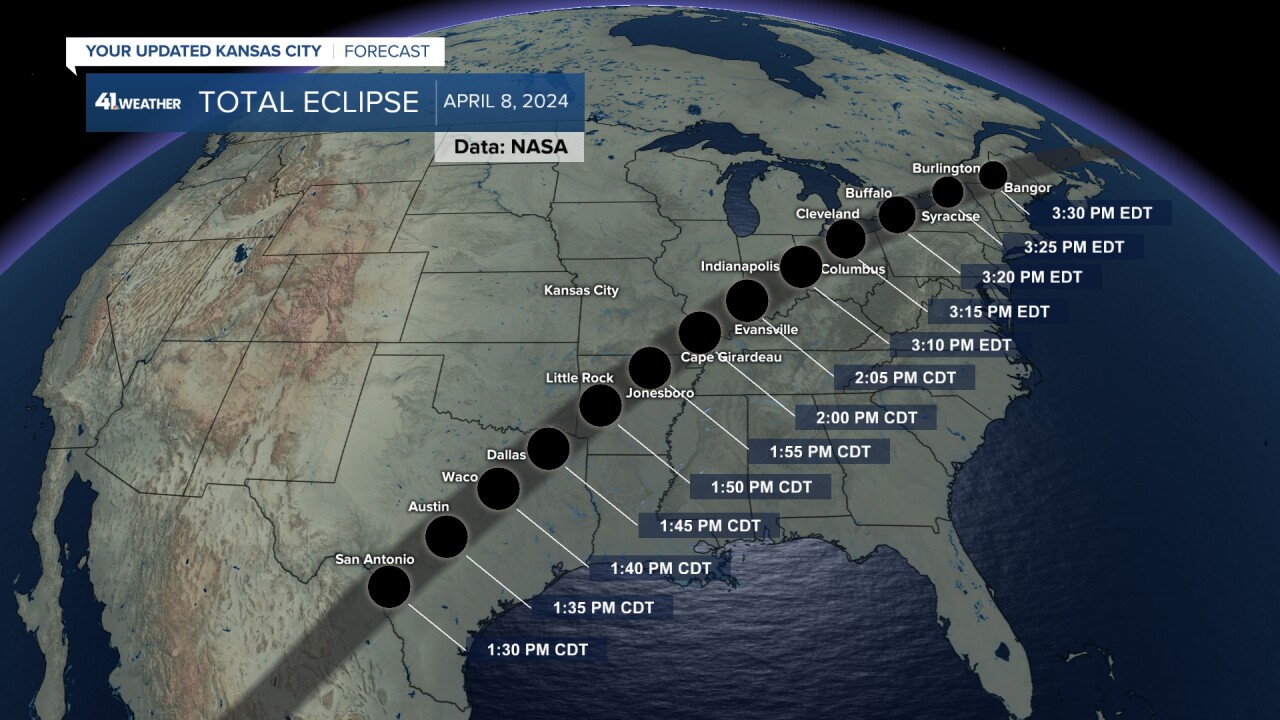Good Tuesday, readers —
We've got a pretty cool astronomical event coming up this weekend, but before you read too far into this blog, just know our viewing isn't looking all that great for it.
Regardless, I've got all the solar eclipse details compiled for all you stargazers in this blog.
First things first, did you know there are four types of eclipses?
- Total Solar Eclipse — happens when the Moon passes between the Sun and Earth, completely blocking the face of the Sun.
- Annular Solar Eclipse — aka the ring of fire — happens when the Moon passes between the Sun and Earth, but during a time in the Moon's orbit when it is farther from the Earth, so it doesn't fully cover the Sun and the max eclipse creates a ring of light around the Moon.
- Partial Solar Eclipse — happens when the Moon passes between the Sun and Earth, but the Sun, Moon and Earth and not perfectly lined up, so the max eclipse is a crescent-shaped Sun.
- Hybrid Solar Eclipse — happens when an eclipse shifts between annual and total as the Moon's shadow moves across the globe due the the curvature of the Earth. Some see a total eclipse, but others see the ring of fire.
This upcoming eclipse on Saturday, Oct. 14, is an Annular Solar Eclipse, meaning the Sun will only be 90% covered and at max eclipse will produce a ring of sunlight (or fire) for those in the best viewing areas.
In Kansas City, we will have a sun that is 60-70% covered and looks more like a glowing crescent.

The best viewing for this eclipse will start at 10:04 a.m. in Eugene, Oregon, passing through Albuquerque, New Mexico, and ending at 2:13 p.m. in Corpus Christi, Texas.

But cloud cover will certainly play a role in our Saturday forecast across the country.
We've got a coast-to-coast system this week that will bring snow to the Rockies and severe weather to Kansas City. And by the time Saturday rolls around, this system will still be impacting us — not with storms but with cloud cover.
The clash of the seasons is here... this week a system will bring snow and severe weather across the center of the country. Kansas City this means severe storms are possible by Chiefs kickoff Thursday! I've got the latest data coming up on @KSHB41 at 11 am with @DaishaJonesKSHB pic.twitter.com/kDEEKclo4a
— ☀️ Cassie Wilson (@CassieKSHB) October 10, 2023
Not only will a mature low-pressure system be hanging out near Lake Erie, but another low-pressure system will be moving onto the West Coast this Saturday.
Expect both of these systems to bring a lot of cloud cover into Saturday's forecast across the country ... especially here in Kansas City.


So, yeah, it doesn't really matter that the Moon is partially covering the Sun Saturday because it looks like cloud cover will be COVERING UP ALL THE ACTION for us.
But, just for fun, let's talk about what will be going on behind the cloud cover Saturday.
If we had zero cloud cover, the sun would be 60-70% covered, giving us a crescent-sun shape to witness in Kansas City. If you live northwest of KC, the eclipse would show you a 50-60% covered sun.
It's a good reminder to note that during Annular Solar Eclipses, it is never safe to look at the sun directly because it is never fully covered.
The eclipse will start at 10:25 a.m. and end at 1:20 p.m. with the max eclipse at 61% covered in Kansas City at 11:50 a.m.
So maybe set an alarm and see if you can find a cloud break.

If you want to travel Saturday to find a good view of the eclipse, I recommend heading south.
It looks like that West Coast storm could bring cloud cover across the Pacific Northwest, California and into Nevada. There may be some hope for the desert southwest viewing, but it seems somewhat conditional.

The safer spot for the eclipse looks to be through Texas. High pressure should keep skies mostly clear, and viewing from Midland to Corpus Christi looks pretty good.
After a summer of death ridge heat high pressure ... this is one high-pressure system Texans will enjoy.
If you are a die-hard Wildcats fan and heading to Lubbock to watch the K-State vs. Texas Tech game, get there early! The sun will be 88% covered and the max eclipse occurs at 11:44 a.m. in Lubbock.

You can watch the eclipse in the morning and catch the game at night. If you want to make any travel plans for the eclipse, check this link out to find the exact eclipse timing per location.
Interested in more of the science behind eclipses? Wes Peery has you covered!
He did a great Weather Academy this week breaking it down.
—
Are you upset you won't be able to really see the eclipse this weekend, well don't worry. Our next eclipse is a TOTAL eclipse and is only 6 months away!

Mark your calendars for April 8th, 2024. This eclipse will be much closer to Kansas City and we are expected to be in the 80-90% covered viewing path. So you will see a pretty good eclipse by just staying home or you can take a short drive and plan a trip to catch the full impact.

But remember that April is the beginning of severe weather season so storms and cloud cover may be an issue with this next Eclipse also. I mean we will in Kansas City after all... the weather is always throwing us curve balls! Here's a look at the viewing coverage map for the entire US come April.




